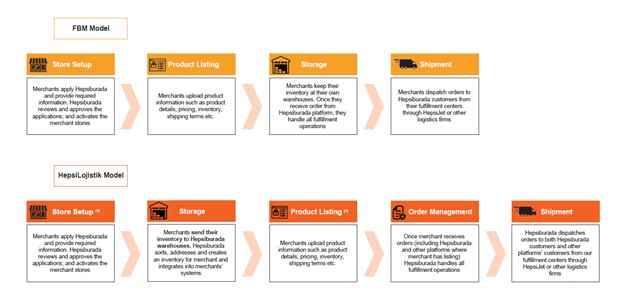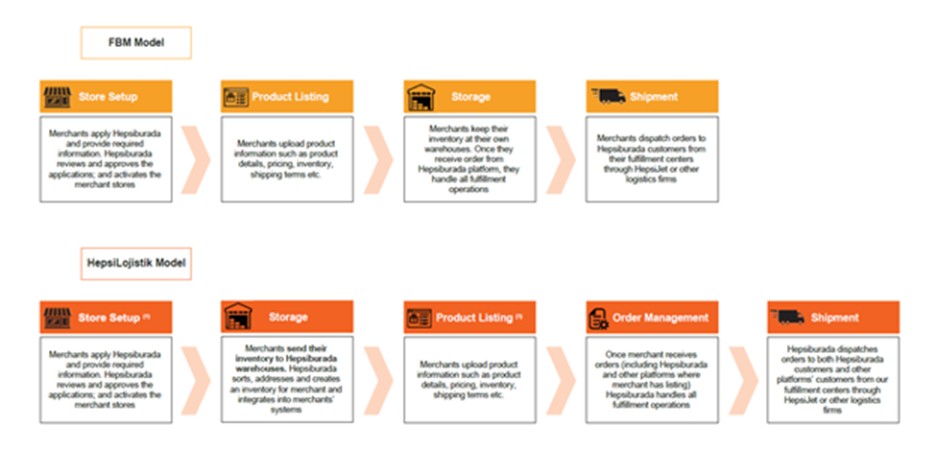Our trade payables and payables to merchants mainly include trade payables to retail suppliers (for merchandise purchased for our 1P-model business) and trade payables to service providers and to merchants (representing payables related with the products delivered by our merchants to our customers). As of December 31, 2022,2023, our trade accounts payablepayables and payables to merchants amounted to TRY 5,886,53810,562,999 thousand. Our trade payables and payables to merchants increased by TRY 863,578 thousand, compared to December 31, 2022, mainly due to an increase in inventory procurements in the fourth quarter of 2023 compared to the same period of 2022 and increased service payables such as advertising, shipping and other operational expenses. The payable days for our suppliers as of December 31, 2023 was 65 days, down from 70 days as of December 31, 2022, mainly due to a change in the mix of sales towards the suppliers with relatively lower payment days.
As of December 31, 2022, our trade payables and payables to merchants amounted to TRY 9,699,421 thousand. Our trade payables and payables to merchants decreased by TRY 786,3381,295,672 thousand, compared to December 31, 2021, mainly due to a higher volume of inventory procurements in the fourth quarter of 2021 and increased service payables such as advertising, shipping and other operational expenses, whereas the inventory level had significantly declined as at December 31, 2022. As of December 31, 2021, our trade accounts payable and2022, the average payables to merchants amounted to TRY 6,672,876 thousand. Our trade payables and payables to merchants increased by TRY 2,147,207 thousand, compared todays for suppliers was 70 days, down from 113 days as of December 31, 2020, mainly due2021, consistent with the declining trend in inventory turnover days (due to a higher volume of inventory procurements in the fourth quarter of 2021our sell and increased service payables such as advertising, shipping and other operational expenses.pay payables).
As of December 31, 2022,2023, the average maturitynumber of our outstanding trade payables and payables to merchants were 57inventory days for suppliers and 21was 58 days, for merchants compared to 42up from 51 days and 21 days, respectively as of December 31, 2021. The increase in2022. During 2023, we slightly increased our inventory days to achieve a sustainable inventory level for our operations. As of December 31, 2022, the average maturitynumber of outstanding trade payables from 42 to 57inventory days was mainly due to a decrease in inventory procurement and discontinued inventory purchases with shorter payments,51 days, down from 88 days as of December 31, 2021, in line with our efforts to reach sustainableambition for a better inventory levels. As a result, our trade payable balance also decreased. As of December 31, 2021, the average maturity of our outstanding trade payables and payables to merchants were 42 days for suppliers and 21 days for merchants compared to 53 days and 21 days, respectively as of December 31, 2020. The decline in the average maturity of outstanding trade payables from 53 to 42 days was mainly due to our continued inventory purchases in December 2021 with shorter payment terms for Direct Sales operations to mitigate our exposure to global supply chain shortages and to secure adequate supplies for sales on our platform in the first quarter of 2022. Therefore, our inventory balance as at December 31, 2021 was TRY 1,116,726 thousand higher than it was on December 31, 2020.level management.
Our trade receivables mainly include trade receivables related to cheques received through corporate sales, credit card receivables, receivables from suppliers (receivables under rebate invoices issued to the suppliers where our rebate receivables from a supplier exceed the payables owed to that specific supplier at the reporting date and the net receivable from that specific supplier is classified in trade receivables), Buy-now-pay-later receivables and receivables of HepsiJet from its customers. As of December 31, 2023, our trade receivables amounted to TRY 2,373,275 thousand, compared to TRY 1,094,456 thousand as of December 31, 2022. The increase in our trade receivable balance was mainly due to the increase in buy-now-pay-later receivables. As of December 31, 2022, our trade receivables amounted to TRY 664,2211,094,456 thousand, compared to TRY 369,100608,176 thousand as of December 31, 2021, mainly due to buy-now-pay-later and corporate sales receivables.
As of December 31, 2022,2023, the increasedecrease in other current assetsprovisions was mainly due to an increasethe provision relating to the settlement of previously disclosed class action lawsuits which was reversed upon payment of the settlement expense in deferred VAT balance. As of December 31, 2021, the increase in other current assets was mainly due to an increase in deferred VAT balance and prepaid expenses.2023. As of December 31, 2022, the increase in provisions was mainly due to the provision relating to the settlement of previously disclosed class action lawsuits. As of December 31, 2021, the increase in provisions was mainly due to the provision relating to the competition board investigation.
As of December 31, 2022, the increase in other current assets was mainly due to an increase in deferred VAT balance.
The average maturity of our trade payablespayable days exceeds the average maturity of our trade receivablesreceivable days and due to our high rate of inventory turnover, we maintained a negative net working capital position as of December 31, 20222023 and December 31, 2021,2022, respectively.
The continued negative net working capital position is mainly due to the use of cash to pay the following:
| ·
| operating expenses such as:
|
| o | advertising expenses (TRY 1,765,278 thousand, TRY 2,950,767 thousand and TRY 1,526,765 thousand for the years ended December 31, 2022, 2021 and 2020 respectively), |
| o | shipping and packaging expenses (net of delivery service revenues) (TRY 108,639 thousand, TRY 414,253 thousand and TRY 218,808 thousand for the years ended December 31, 2022, 2021 and 2020 respectively), |
| o | payroll and outsource staff expenses (TRY 1,790,091 thousand, TRY 1,587,567 thousand and TRY 794,492 thousand for the years ended December 31, 2022, 2021 and 2020 respectively), |
| ·
| capital expenditures (TRY 859,833 thousand, TRY 414,091 thousand and TRY 243,980 thousand for the years ended December 31, 2022, 2021 and 2020 respectively, also see “— Capital Expenditures”).
|







